|
|
Post by oozlefinch on Feb 14, 2013 13:06:39 GMT 8
Fots - great job of camera work. I'm still not convinced that the generator was moved into the SL tunnel, but we'll never have a definitive answer to that puzzling question. I have another question for you, when you have the time. Have you accounted for all 4 of the gun shelters on the hill? Just wondering.
|
|
|
|
Post by oozlefinch on Feb 14, 2013 14:05:49 GMT 8
Dummy me! Fots, you said earlier in this thread that there were 3 shelters. I got out my magnifying glass, and the '36 map, and it shows arrows pointing to 4 shelters. Please correct me if I'm wrong.
|
|
|
|
Post by fots2 on Feb 14, 2013 14:14:52 GMT 8
Hi oozlefinch,
The subject of four 75mm gun shelters on top of Malinta Hill is a bit of a puzzle. Have a look at the discussions about this on page 17 of this thread. The detailed 1936 map shows only three shelters but the actual locations are incorrect based on the remnants of them that we see today.
The answer to your question is NO, I have only found three which are quite visible. I see no unknown pile of rebar and concrete rubble that could possibly have been a fourth shelter. Do you have any information that tells us that there were actually were four shelters? Do you have photos of all of them from your trips up Malinta Hill? |
|
|
|
Post by fots2 on Feb 14, 2013 14:24:54 GMT 8
After finishing up my measurements and videos I was just standing back and looking at the area where we expected the pom pom gun to have been mounted. Using the Japanese newsreel screen capture seen below, I drew an imaginary line running through the 75mm gun shelter from south to north up over the little hill. The pom pom gun appeared to be to the right of the line. 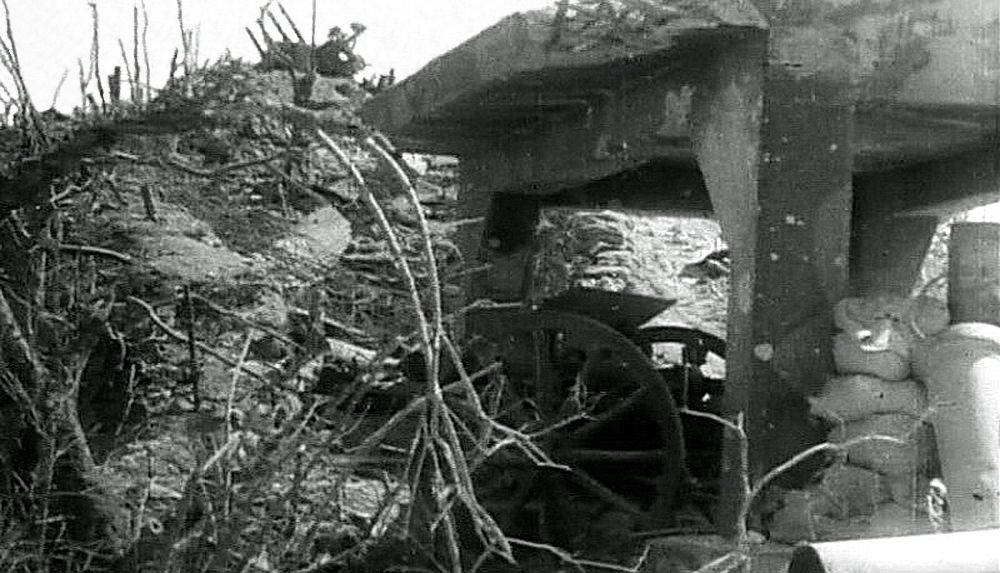 Screen capture of the 1.1” Pom Pom gun on top of the hill taken from a May 1942 Japanese newsreel. During the earlier wet season you cannot see through the dense vegetation more than a few feet. On this day, mid January, the scrubby trees and bushes were still there but the leaves were mostly gone making ground visibility much better. The amount of ridge between the magazine and the SL #8 air shaft is actually quite small so I wandered in there and started kicking around. 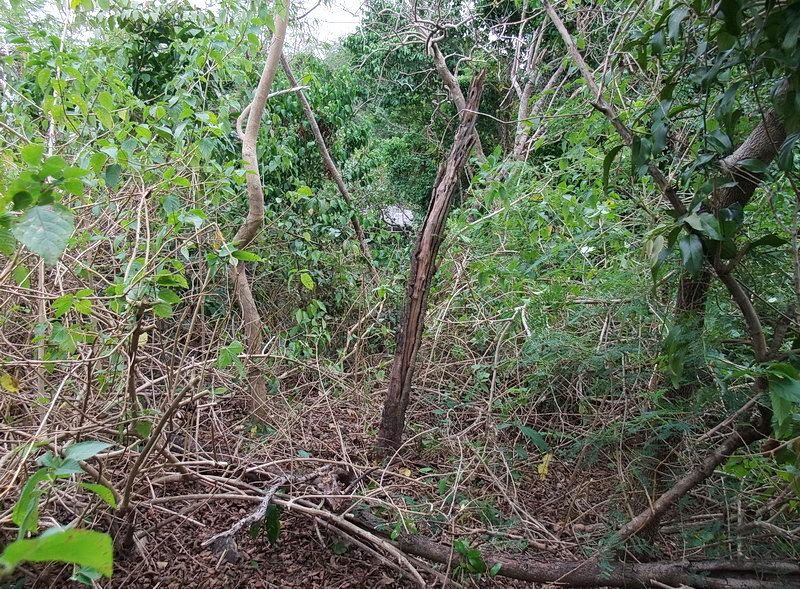 Sample of the area between the magazine and the SL #8 air shaft. One little area had no trees growing but lots of bushes hid the ground. Once in there I noticed a 6” diameter metal pipe sticking up out of the soil about three inches high. I started to clear this spot and it looked more promising all the time. A concrete edge soon showed up. I scraped away the soil in 5 or 6 test holes and found concrete on the bottom ol all of them. Here was a concrete pad encircling the metal pipe. I did not find any bolts or signs of cut-off bolts in the concrete.  After clearing away some larger bushes, this pipe came into view. 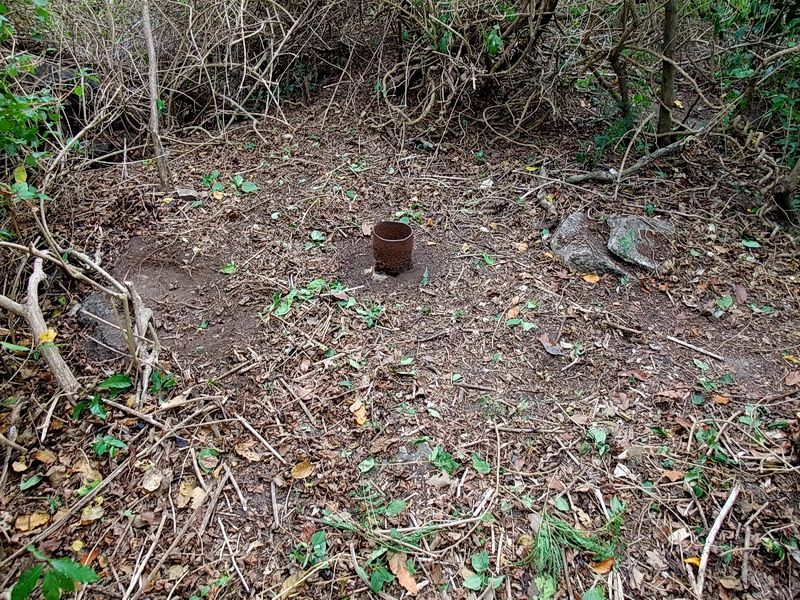 Some more clearing turned up the edge of what appears to be a circular pad of concrete. As a position reference, note the dark area past the pad in the upper left corner of the photo. This is the large hole at the rear entrance of the magazine. The concrete seen to the right of the pipe are just two loose chunks lying there. 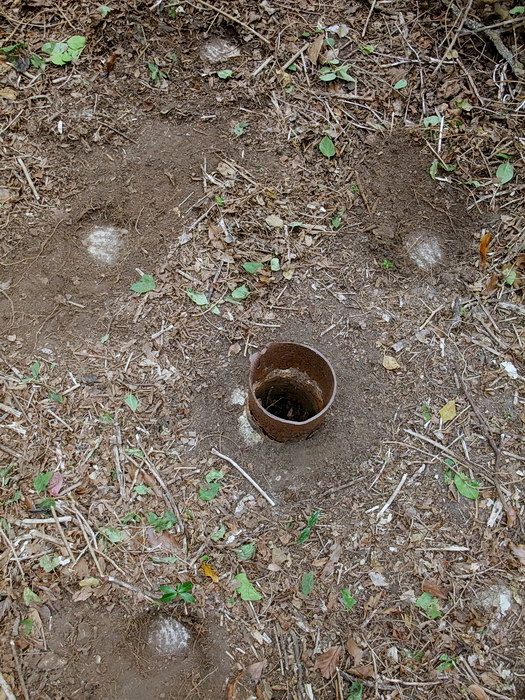 A few test holes all uncovered grey concrete. Finally, I had found a concrete pad at the top of the little hill just where we all expected it to be. I looked around for anything else and saw two blocks of concrete with dimensions similar to railroad ties. One is nearly buried but the other one has two bolts sticking up in a staggered pattern, not what you would expect if they were for a building. I wondered if these were part of the actual gun mount since I did not find a circular pattern of bolts on the pad. There may be more of these blocks buried around here. 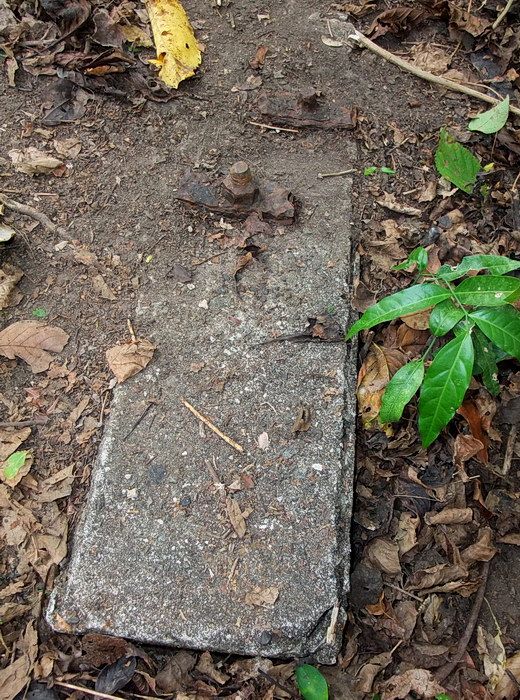 One of the concrete blocks. 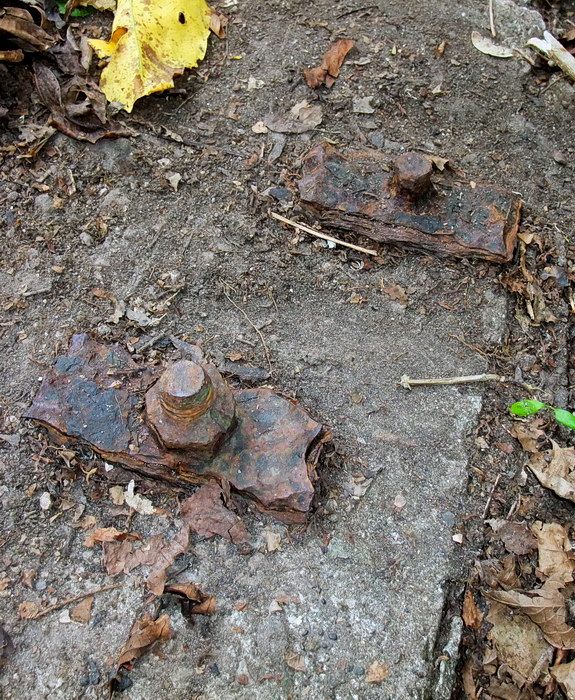 A close-up of the staggered bolts. As a final clue that the location of the pom pom gun mount is where we expect it to be, I took this photo near the concrete blocks which are nearly on the imaginary line I drew earlier from the center of the 75mm gun shelter. When in the gun shelter looking north, the pom pom gun appeared to be on the hill to the right of the line. Now when looking south, the concrete pad is on top of the hill to my left where it should be.  On top of the little hill looking down at the roof of the 75mm gun shelter. The concrete pad is to my left. The significance of the cut-off pipe did not dawn on me until that evening when I had a look at the screen capture of the Japanese newsreel again. Front and center in the photo is a metal pipe (label #1) that appears to be of similar diameter to the one in the concrete pad. One of you guys had mentioned this before. Even more of a surprise was what I noticed next. What appears to be a slightly smaller diameter pipe is at the bottom of the pom pom gun (label #2). Could the physical mounting of the gun have been by placing the pipe (label #2) onto the pipe (label #1)? 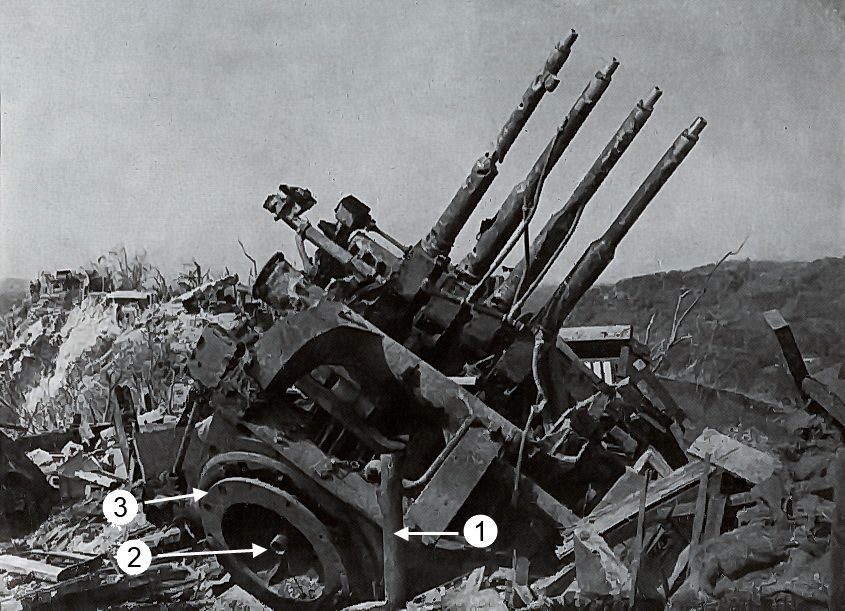 Screen capture of the 1.1” Pom Pom gun taken from a May 1942 Japanese newsreel. In our discussions we have noticed that the base ring containing the bolt holes shows little to no damage (label #3). This is not what we would expect if the gun was secured by a ring of bolts and later blown off it’s mount. i.e. no warped or broken ring, no bolts ripped up, chunks of concrete hanging down etc. Is this because there were no bolts in the pad to attach to? The pom pom was a hurried installation during wartime so perhaps the minimum workable mount is all that was constructed. Recoil of the guns would push the whole pom pom down but I would still expect it to bounce somewhat on the pipe when in operation. (that opinion comes from zero experience, just a SWAG). Did the concrete blocks with bolts in them play some role in an alternate method of securing the gun? Here is a short video of the concrete pad and pipe on top of the hill. I don’t doubt that this is the location where the pom pom was mounted. The area along the narrow ridge is so confined that it could not have been any where else. The pad sits on a level spot at the top of the little hill which certainly gave an unobsrtucted 360 degree field of fire. Now here is another SWAG for the day. After viewing the photos and a video perhaps you and olka etc can interpret what we see here and what happened in 1942. Was the blast from the Japanese artillery shell so powerful that it bounced the unbolted pom pom gun off the center pipe? I suppose stranger things have happened in war. Someday I will go back up there and clear the shallow layer of soil from the concrete pad. As I mentioned, my test holes did not uncover any circular bolt pattern but it would be interesting to know if any other method of securing the gun is obvious. I’ll take a few photos and then cover it up again. |
|
|
|
Post by pdh54 on Feb 15, 2013 10:40:32 GMT 8
WOW Fots,  Excellent pictures, video, info and SWAGS! Chad is just itching to get home and absorb all of this! I read him your post and sent a few photos by phone. I can just see the wheels in his brain working. Hahaha One thing.....That pipe is very tall compared to the pompom gun. The pipe doesn't look damaged either. What about the thought that the Japanese were in the process of dismantling and removing the gun for whatever reason. Just a thought. Patty |
|
|
|
Post by fots2 on Feb 15, 2013 12:54:46 GMT 8
Hi Patty,
I remembered Chad suggesting the “pom pom gun might have been removed and sent to Japan” but did not want to say anything until someone mentioned it. As far as I know, this is the last photo ever taken of this gun so that may be true.
Two things seem a bit strange about that though. Wouldn’t work on such a heavy gun require that they had a cleared work area to place jacks or whatever tools were necessary? In the photo the base of the gun is still littered with wood, rock and concrete debris. A man could hardly stand up there not to mention a whole work crew. Second, being lazy, I would raise the gun a few inches and then just cut off the center pipe. Why raise it all the way up and over the end of the tall pipe?
The “bounced up off the pole” theory seems a bit far fetched to me, especially since it is still exactly vertical with no bends at all.
All options are still open. Chad will solve this mystery.
|
|
|
|
Post by oozlefinch on Feb 16, 2013 13:59:39 GMT 8
Fots - I'm still waiting for my slide projector to get fixed. It's hard to find someone now days that know how to fix them. Between my '87 and '89 trips I took nearly 3,000 slides. It's been nearly 25 years since those trips, and at the time I really didn't think I would be in a discussion like this so I didn't take notes. As to the pipe SWAG, I wonder whether the pipe shown in the pic is a little long. It looks like it's around 24", or so. Although I've never seen a real 1.1, I did take a look today at both a twin 40mm gun mount, and a quad 40mm mount, and neither would have allowed for a pipe of that length. Assuming that it did, the mount would probably have needed additional support. The concrete pieces with the bolts might have added to the stability. The distance between the bolts look close to the distance between the bolt holes on the base. As has been stated, both the RJ-43 gun, and the 1.1 were hastily mounted, so who knows what the foundation really looked like. Does anyone know when the gun was actually brought over from Cavite?
|
|
|
|
Post by chadhill on Feb 18, 2013 7:17:06 GMT 8
Very, very good work, fots! After studying your photos, video and "imaginary line" from the 75mm shelter, and comparing them with the Japanese newsreel and PEF photo of the overturned gun, I am convinced that you have found the site where the elusive pom-pom was located. Everything checks out. This is a historical find. Congratulations on a job well done! I have a SWAG about the two "railroad tie" sized concrete blocks with bolts. They seem to be close to each other in the video, and I think it's possible that the Crosely automobile motor, rigged by Gunner Otto to drive the water pump that cooled the barrel jackets, may have been mounted there. (photo courtesy oldcarandtruck pictures.com)  I feel sure and would wager very good money that the pipe you found is what remains of the one seen in the Japanese photo. Great discovery, even more evidence! However, my gut feeling, like oozlefinch's, is that the pipe shown in the Japanese photo was too tall to fit inside the gun mount. This photo of a pom-pom at the USS North Carolina ship museum shows the height of the base ring and mount apparatus; it would seem to be a tight fit at best: (photo courtesy The Safety Officer at 61oldsalt91.blogspot.com)  Another gut feeling is that the small diameter pipe on the bottom of the gun (label #2 in your Japanese photo) is the lower part of a hub housing that passes through the base ring. That's just a SWAG, I've been searching for a manual about the Hudson 1.1 inch AA gun but have had no luck so far. Even though you found no mounting bolts in the main concrete pad, I think the weapon must have been secured by some means. Besides recoil, it of course would revolve and change barrel elevation while tracking an aircraft, and therefore need steady mounting. Rather than using embedded bolts planted in wet concrete, the pom-pom could have been attached to the pad using wedge anchor drop-in sleeves and expansion bolts. Then, after the bolts were removed to dismantle the gun, only the holes in the concrete would remain, filled today with 70+ years of soot. Just another SWAG... Again fots, a tremendous job! My hat's off to you.   |
|
|
|
Post by chadhill on Feb 18, 2013 8:37:43 GMT 8
Oozle, I've been unable to learn exactly when the pom-pom came to Corregidor. There have been a few reports that it went from Cavite to Mariveles first, but as far as I know that hasn't been proven. John Gordon uncovered some info on the weapon, writing that it was sent from Cavite to Corregidor with 25,000 rounds of ammo aboard a lighter, and that it was disassembled (my italics) prior to being emplaced atop Malinta Hill. LTCOL Barr, in his history of Battery Mobile, wrote that the gun was installed in late January, and that the sandbagging and camouflage around it was done by LT Friedline. Most sources say the weapon first saw action on February 11th.
* * * * *
Late update:
I came across this quote from John Gordon on the network54.com forums, dated January 15, 2012:
"I did, however, note in the 16th Naval District War Diary (a copy of which I have) that the 1.1 mount that ended up on Malinta Hill was sent to Corregidor via lighter on 17 December. A few days later there was a request (within Navy-USMC channels in the Philippines) to set the mount up near Mariveles. As you know, the 16th Naval District instead turned the mount and ammunition over to the Army".
|
|
|
|
Post by fots2 on Feb 24, 2013 8:45:43 GMT 8
A few days ago Phantom and I into walked up to the top of Malinta Hill to further examine the Quad 1.1” Pom Pom gun mount. With a little six-inch shovel and a mini brush, we planned to clear the roots and dirt away to expose whatever was hiding. On my previous visit last month I had just cleared bushes and leaves from the immediate area.  Photo taken last month of the metal pipe and buried concrete pad. There were many roots growing across the pad but after cutting them, the 2 to 6 inches of dry loose soil scraped away easily. We were in for a surprise...surrounding the metal pipe is a steel ring containing 12 bolt holes. This appears to match the base of the overturned Pom Pom as seen in the Japanese photo. The steel ring is more than ½ inch thick. I wonder if in addition to receiving the gun and ammunition, Corregidor was also shipped miscellaneous mounting materials which would explain the ring. Any doubt to this being a gun mount was long gone now. 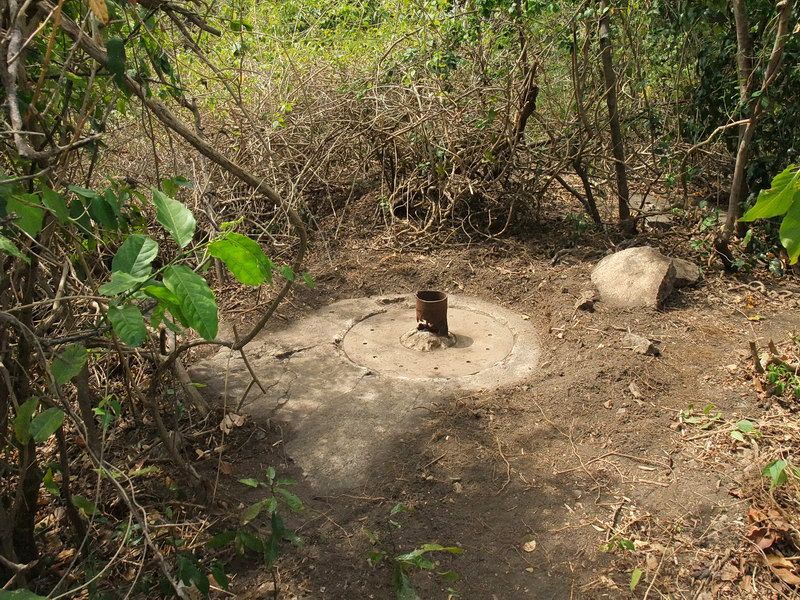 The view as you approach the gun mount. 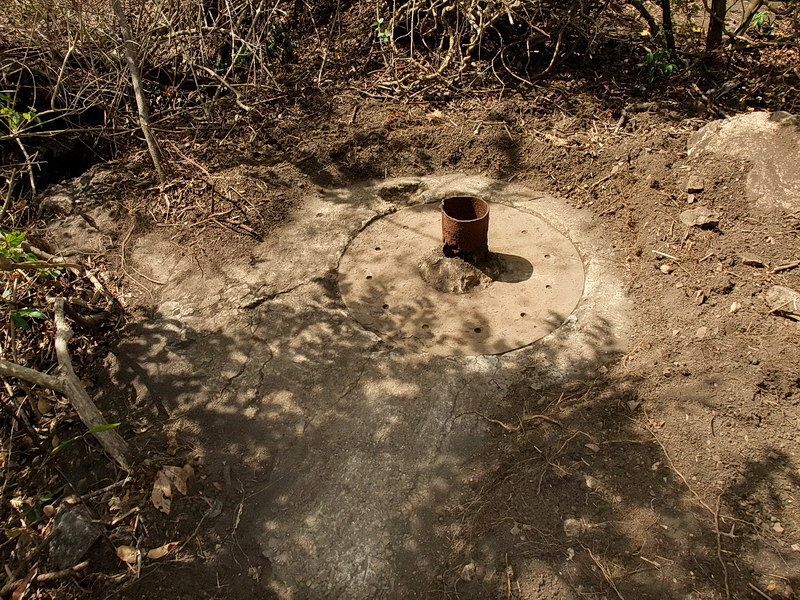 We have often mentioned how the base ring of the toppled Pom Pom has very little damage which is not what would be expected if the gun was bolted to the steel ring and later blown off of it. I think we have proof here that the gun was NOT bolted down to the ring in the mount. Look at the position of the pipe w.r.t. the placement of the ring. The pipe is offset by a huge amount so the gun’s pipe and bolt holes would not line up with the mount’s pipe and bolt holes. Note the offset pipe in the next two photos. 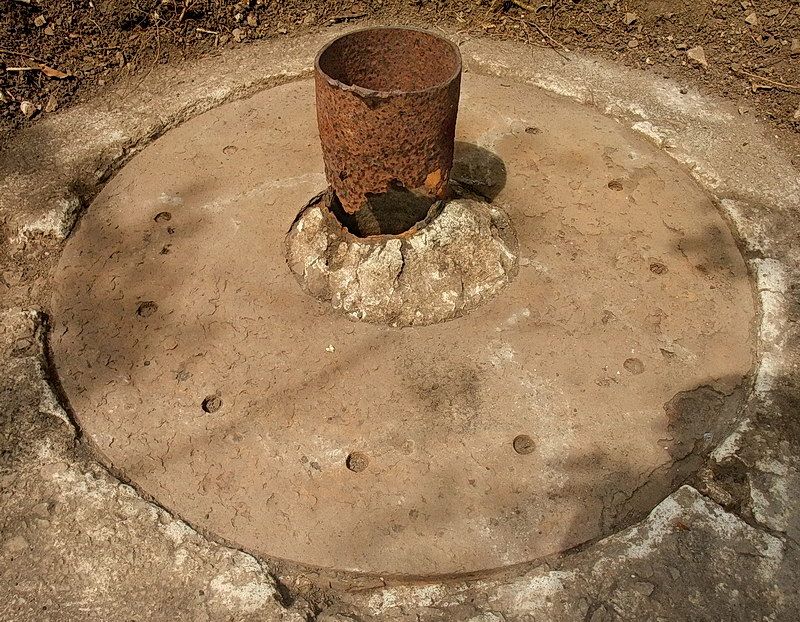 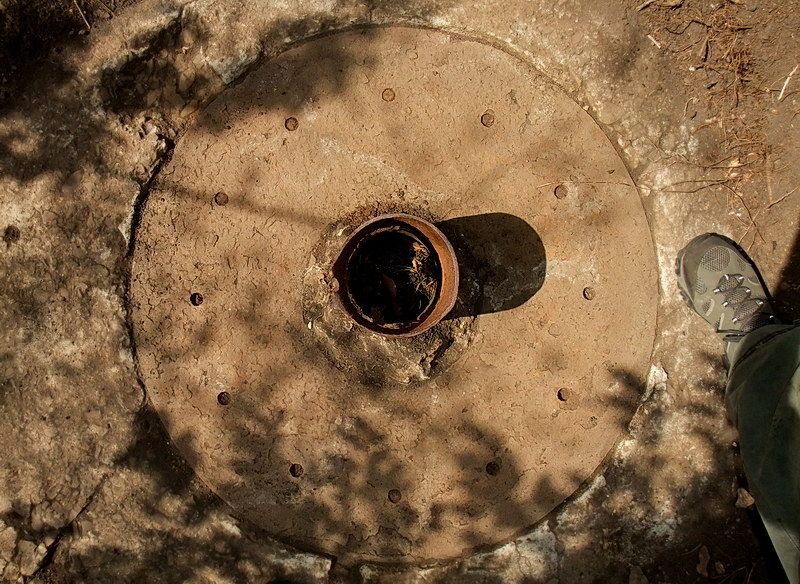 It is not important but I had assumed that the concrete pad was circular which does not appear to be correct. This trip I noticed one intact corner that indicates it was a square shape. 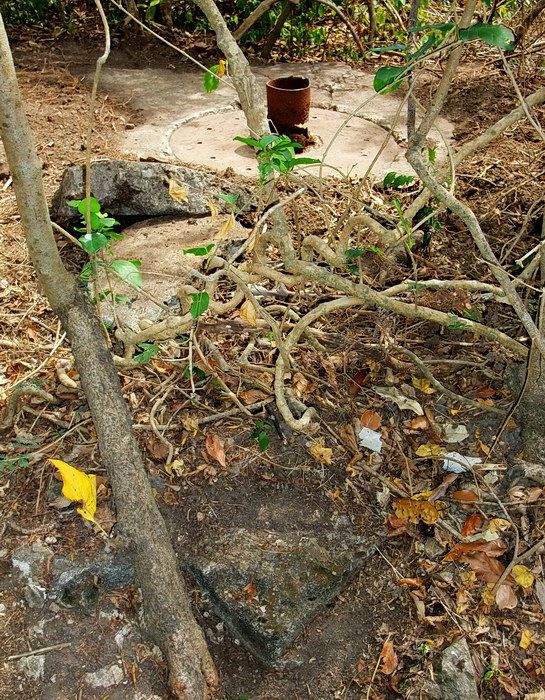 One concrete corner can be seen at the bottom center of the photo. 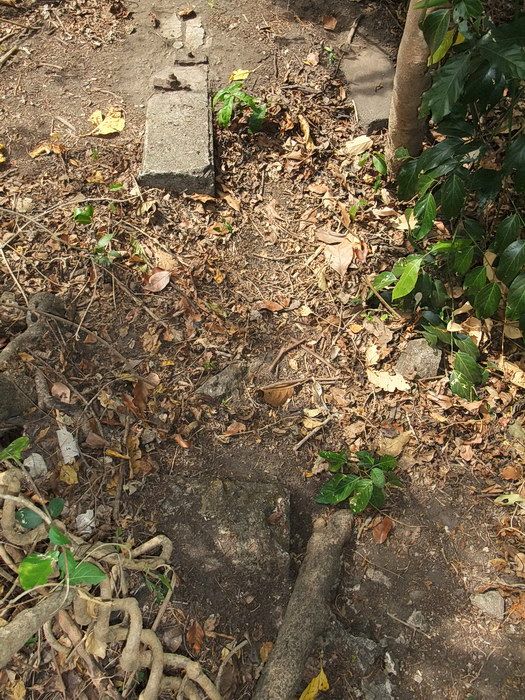 From the same corner, now we are looking towards the two concrete blocks. The bolts appear to be the same diameter as the holes in the steel pad which may or may not be significant. Here are a few more photos of the gun mount. 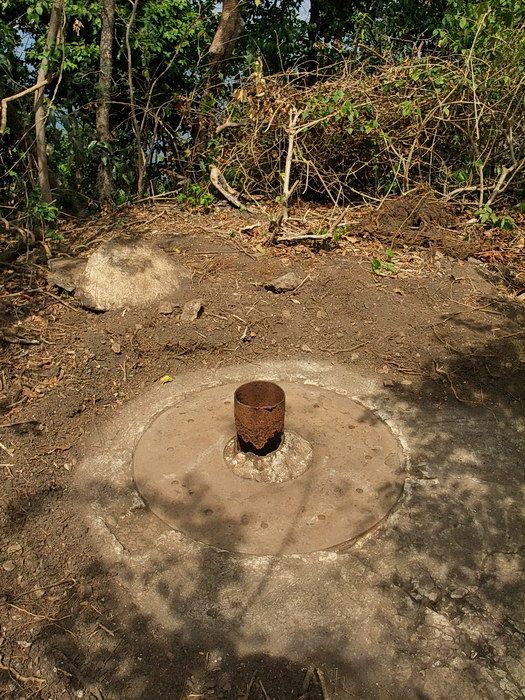  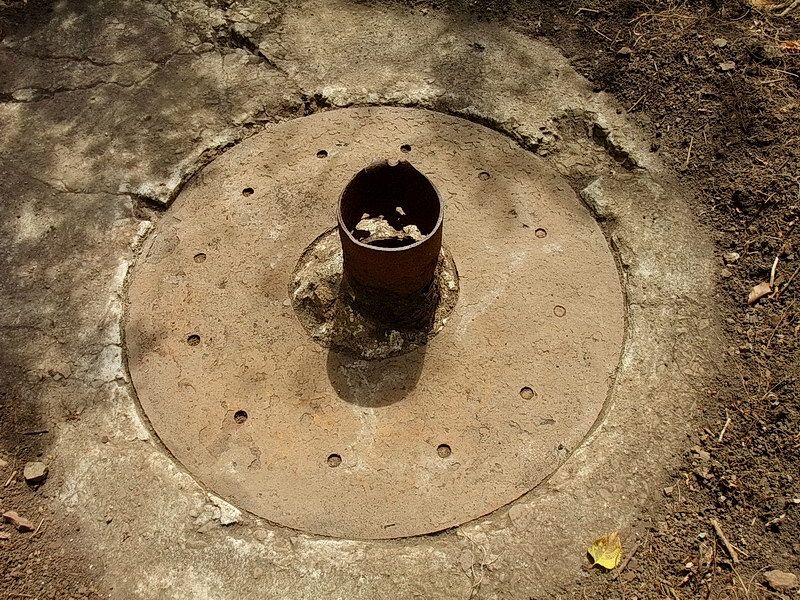 To protect the steel ring and generally restore the site to the state in which I had found it, we covered everything up again with dirt and bushes. As we were doing this Corregidor revealed one more little secret to us. Off to the side of the gun mount were two chunks of concrete. Phantom noticed a boot print in one of the pieces which we were looking at. I decided to add the concrete to help cover up the pad so I turned one piece over. It was rounded which was unusual but one feature really caught my eye. The tapered end of the concrete was curved which seemed to match the shape of the metal pipe. I moved the concrete up to the pipe and it was a perfect fit. The second chunk of concrete had a similar shape and it not only fit the pipe but fit exactly into the first piece of concrete. These were clearly two pieces of a top ring of concrete around the metal pipe. Here was further evidence that the gun was not bolted to the steel ring as this concrete ring covers up the bolt holes. I agree that the gun must have been secured to the mount in some fashion but this does not appear to be how it was done. 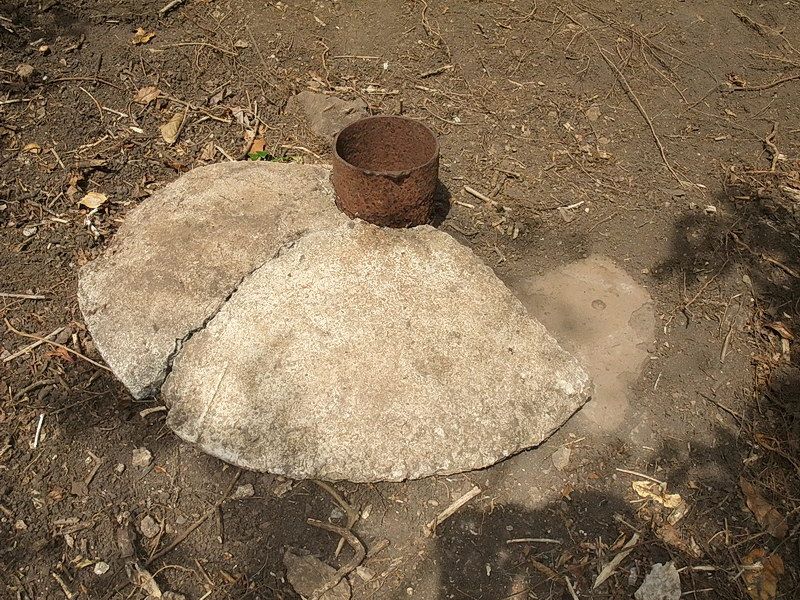 The two chunks of concrete fit together perfectly and surround the metal pipe. 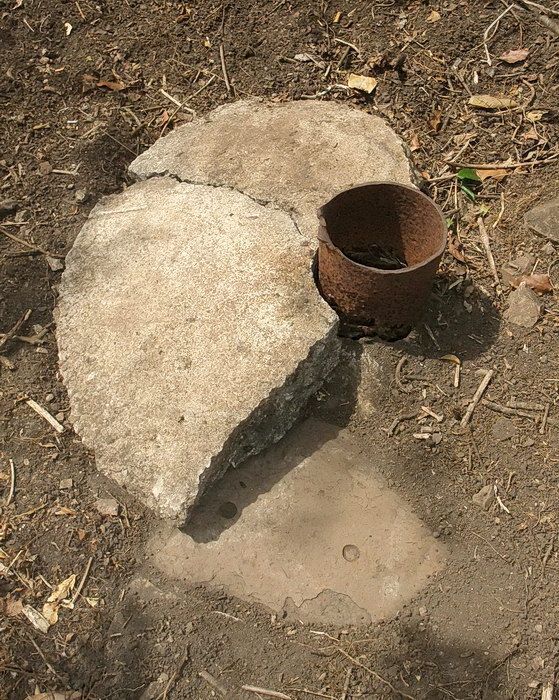 Note that this upper concrete ring conceals the bolt holes. We finished covering up the concrete pad, threw down some sticks and bushes then moved on. After the next rainy season this site will look natural again. 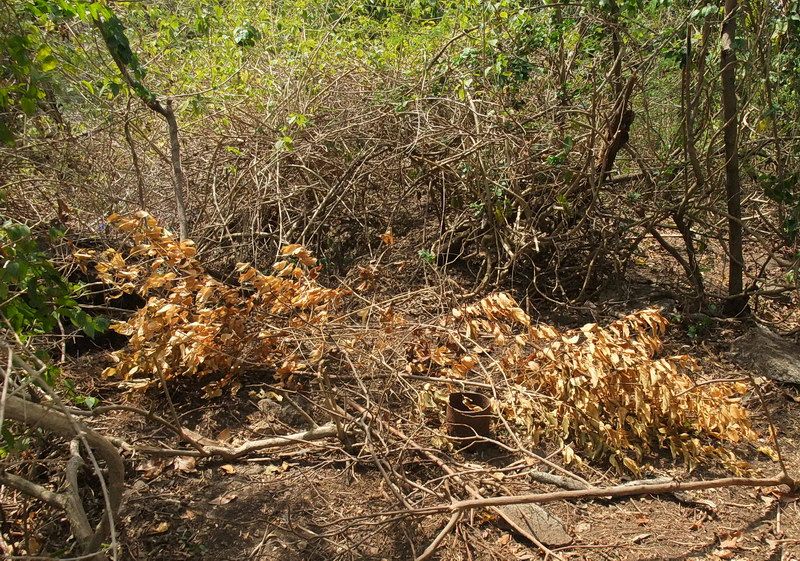 Phantom and I spent the rest of our time on the hill wandering around and kicking the dirt where ever we went. From what we saw, we are in agreement that there were three gun shelters up there and not four. These three match exactly with what is seen on armyjunk’s aerial photo. The 1936 map also shows three shelters but not in the exact positions we see them at today. Thanks to Phantom for the help that day and his usual eagle eyed perspective. Also, thanks to everyone who posted in this thread to help us locate where a piece of Corregidor history was actually mounted 71 years ago. |
|